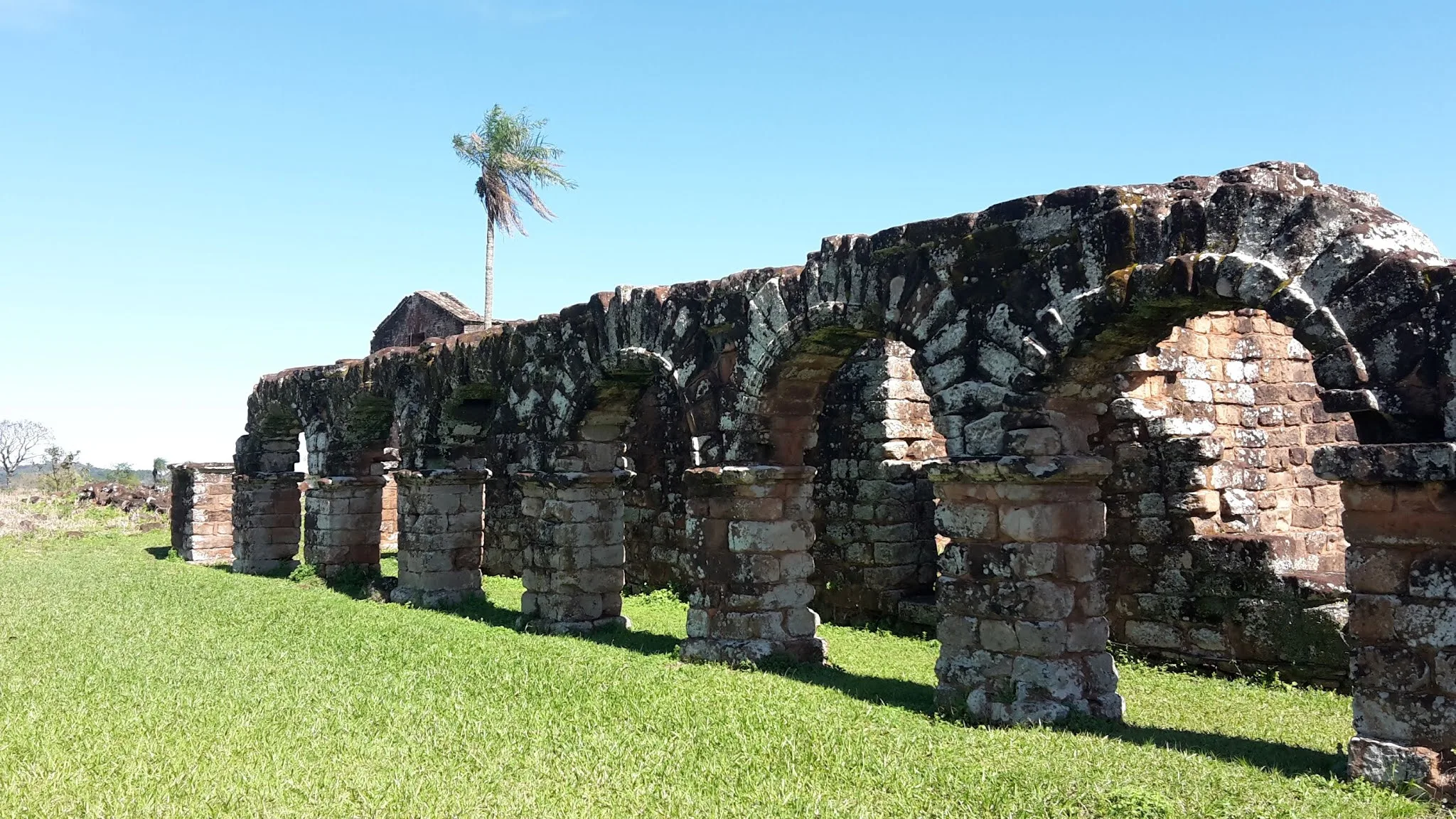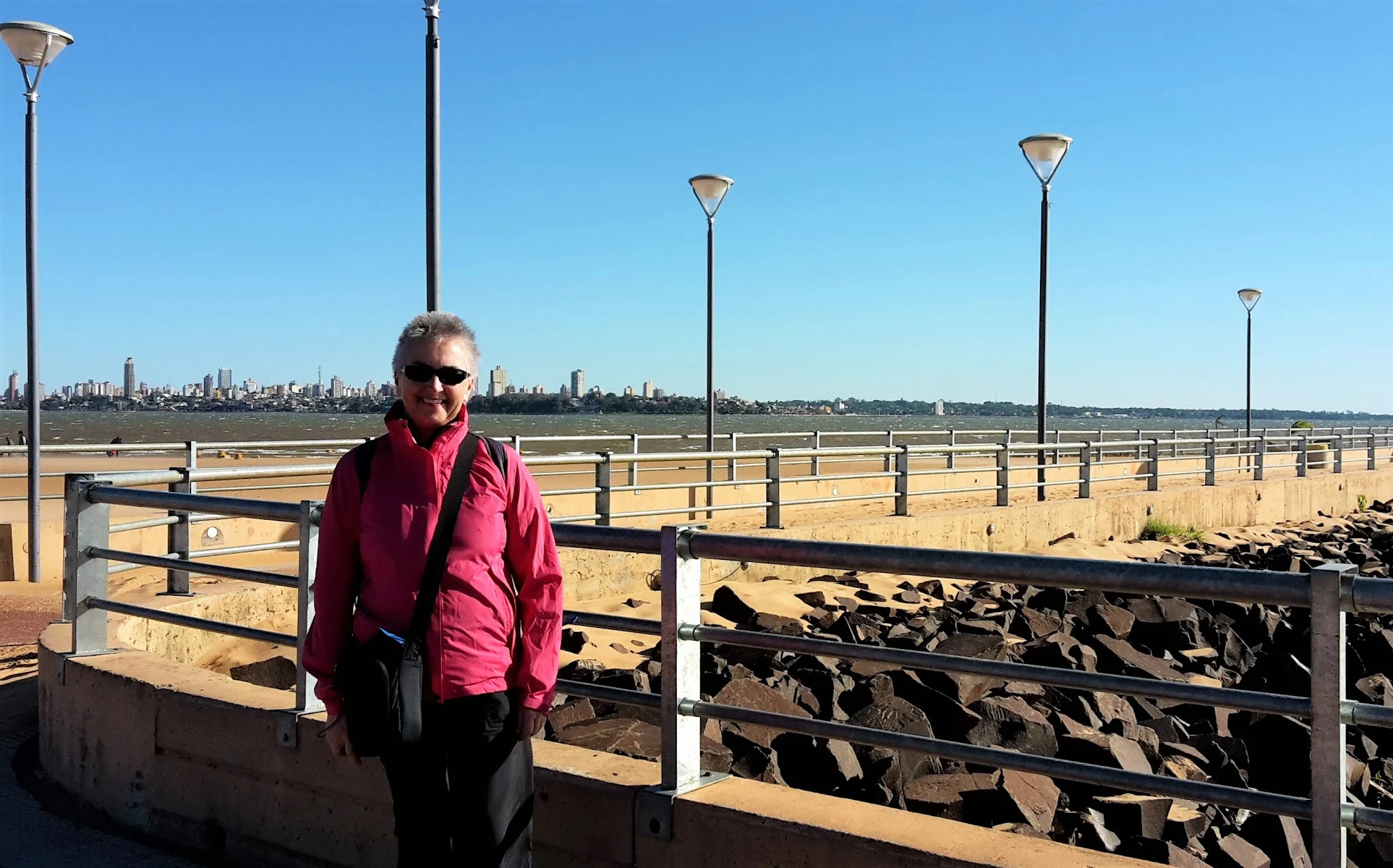We’d taken a taxi from Posadas in northern Argentina, across the border
to Encarnación in Paraguay, a small country of 7 million mostly mestizo people, wedged between Argentina, Brazil and Bolivia. We had to cross a bridge over the Paraná River to cross the border, but border procedures were surprisingly quick, and we were soon in Encarnación city, our destination for the next few days.
 |
| Marg in the Plaza de Armas, Encarnación |
As we were about to leave our hotel to explore Encarnación city, there was a heavy rainstorm. Thankfully our hotel loaned us a big umbrella. We were staying at the Del Rio Apart Hotel right in the city. It had definitely seen better days, but the bed was comfortable, the bathroom clean, and the location great.
The rain didn't dampen our enthusiasm, and after exchanging some
Argentinian Pesos for some Paraguayan Guaraní, we had money to spend while we wandered around.
The guide books call Encarnación, Paraguay’s
most attractive city. However, we think of it more as a city of contrasts.
 |
| Scruffy apartment block in Encarnación, Paraguay |
We saw a lot of run-down and scruffy houses and
apartments, right alongside a few much larger and more affluent ones. The shops and commercial centre looked tired,
and the footpaths were a definite challenge with many holes and serious
undulations.
The run-down look is symptomatic of Paraguay's history of political repression and poverty, and obviously Encarnación has not been exempt from this.
However, there is a newly developed riverside walk that provides a modern and lovely recreation area, seemingly against the odds.
It has a well-lit promenade meandering alongside a
sandy beach, grassy parks, cafes and restaurants. It looked very pretty at night, especially
looking back across the Paraná River to the lights of Posadas.
We were in Encarnación because it provides
good access to two Jesuit Mission ruins that we wanted to see. They are UNESCO World
Heritage Sites, just on the edge of town.
 |
| Leigh at the ruins of La Santisima Trinidad Mission (UNESCO), Encarnación, Paraguay |
So off we went to visit the first mission called
La Santisima Trinidad. Bumping along in a taxi up the hilly cobbled road to the entrance, we passed
two women in interesting blue hats who were walking there. They caught up to us at the entrance and we learned that they were Aussies from Western Australia.
They were the second pair of Aussies that we had
met within a matter of hours, as we had also met an Aussie couple from the Gold
Coast that morning at breakfast.
We six were probably the only gringos in the
whole of Paraguay at the time, as we didn’t see any others after leaving Encarnación.
 |
| Ruins of La Santisima Trinidad Mission (UNESCO), Encarnación, Paraguay |
La Santisima Trinidad turned out to be fascinating. The
Jesuit Missions were built in the 17th and 18th centuries as miniature city
states to integrate the indigenous Guarani population into the Christian faith.
Whilst we don’t agree with colonisation,
we think that architecturally, it must have been an incredible site in its
time. We enjoyed wandering around there admiring the ruins.
We chatted lots with the two blue-hatted
Aussies, Jacky and Phil, and invited them to share our taxi to the next mission site, Jesus de
Tavarangue.
This mission was never completed as it was still being built when
the Jesuits were expelled from the area at the end of the 18th century. However, you could envisage its significant
size, had it been finished.
We all taxied back to town (no buses on
Sundays) and arranged to meet Jacky and Phil later for a meal.
We met at a
local restaurant and had lots of laughs, sharing travel experiences and blogs. It was a lovely little break, being able to chat in English in a country where Guaraní and Spanish are the main language (very few people here speak English).
 |
| Marg at the ruins of the Tavarangu Jesuit Mission (UNESCO) |
Later on, we said farewell as they were
heading to Peru and we were going to Asunción the next day by bus.
Our bus to Asunción was very sophisticated with big, wide “cama” seats (fully reclining to a bed),
a pillow and blanket, plus lunch and a drink.
 |
| Top (L-R): Santa Rosa Jesuit Tower, San Ignacio. Below: San Roque church, Yaguarón |
The 7-hour trip went fairly quickly as we
bussed our way through small towns, surrounded by very dry land, populated
with churches, cattle, and some crops. Some of the more interesting towns included Santa Rosa, San Ignacio, San Roque González de Santa Cruz, Yaguarón, and Itá.
Arriving in Asunción, we headed to the La Ilona Hospederia Guest House. It didn't look so good from the street but once inside it was a different story.
 |
| The outside of La Ilona Hospederia Guest House, Asunción |
It was an original 1920's house renovated and decorated in an
eclectic deco style by the lovely owner Xoan.
We had a fabulous studio apartment with its
own large patio and in a very private part of the Guest House. Then the weather turned very hot, with temperatures up to 34 degrees Celsius and a scorching wind, so the Guest House air-conditioning and fans were great.
 |
| Our room and patio at the La Ilona Hospederia Guest House, Asunción |
While there, Leigh came down with a nasty sore throat that turned into a cold, so we were very lucky to have a nice spacious place to just chill out for a few days.
We found a near-by shop for our drink and food basics. However, when we tried to buy a bottle of beer there, we couldn't, because they re-cycle their glass - no empty bottle meant no beer. We are advocates for recycling, but when you have a sore throat on a very hot day, a cold beer can be transformational, so we were somewhat tested by not having an empty to exchange!
Marg eventually went up the road to a little grog shop, and when she explained that she had no 'returns', he sold her beer for cash which was a little more expensive, but made us happy.
 |
| Marg in front of the Palacio de los López, Asunción |
A few days later, we were out and about again exploring Asunción. It is the capital of Paraguay, and its biggest city with a population of around 500,000. It is also one of
the oldest cities in South America, dating back to 1537.
It has the same broken
footpaths and mix of houses as in Encarnación, but has smarter buildings, an interesting historic centre, and a lovely beach along the river.
 |
| Architecture in Asunción |
Some of the more interesting buildings were the Panteón del los Heroes, National Congress, the National Cathedral, the Cabildo which is now a museum, the pink Palacio de los López which is the president's office, the simple little Casa de la Independencia, and several business houses and apartment blocks.
After a several days there, we were ready to move on. We headed for the bus station again, where a
helpful chappie got us straight onto a bus to Ciudad del Este, and we were off.
 |
| The bus from Asunción |
He had assured us it was a rapido express bus - yeah right! It stopped to pick up many, many, many people all along the supposedly 5-hour route, then made up time between stops by going VERY rapido….but it took 8 hours.
As in many other parts of the world we have
visited, the bus driver allowed vendors on the bus to sell their wares. Sometimes you just have to go with the flow so
this trip, we twice bought some chipas from local vendors.
Chipas are a Paraguayan specialty. A chipa is like a cheese bread made with manioc flour, and is delicious.
 |
| Mandioca roots |
We enjoyed many meals in Paraguay that included manioc flour. It’s made from mandioca root also known as cassava or yucca. This vegetable grows everywhere and provides a cheaper, more accessible, and gluten-free alternative to wheat or rice flour.
As we got closer to our destination, Ciudad del Este, the standard of some housing seemed to improve, and there was more cultivated land as opposed to grazing land.
 |
| Roadside shops near Ciudad del Este, Paraguay |
We passed through a lot of rather busy and dusty market towns with all sorts of things being sold at the side of the road.
We had read that Ciudad del Este was a pretty
rough border town and not a place to linger, existing only as a city to buy cheap, often counterfeit goods.
However, we were pleasantly surprised at the
moderness and apparent sophistication of the city. It seemed very different to Asunción and
Encarnación, having lovely wide boulevards, greenspaces, and street art.
 |
| Traffic jam in Ciudad del Este, Paraguay |
Unfortunately, there were also traffic jams, making our bus trip last even longer.
Ciudad del Este is on the border with Brazil
and Argentina, and we wanted to get to across the border. We had read that, because the locals are not required to have their identity card stamped, the bus might drive straight through the border without stopping.
We were the only ones on our bus who had to have an exit stamp in our passports, so we had double checked with the driver to make sure he would stop, and also wait for us.
 |
| Street art in Ciudad del Este, Paraguay |
He assured us, with no English/Spanish between us, that he would stop and wait, and that we had a whole 5 minutes to get it done!
And he did stop. So we trustingly left our luggage on the bus, ran in to Border Control, got stamped out of Paraguay very quickly, and then raced back to the bus. He waited - all good.
Next, we crossed the border
bridge leaving Paraguay, and prepared to get stamped into Argentina so we could get to our next destination: Iguassu Falls.
The above blog is part of our 4-month tour of South America. The first blog on this tour is called "Buenos Aires here we come".

